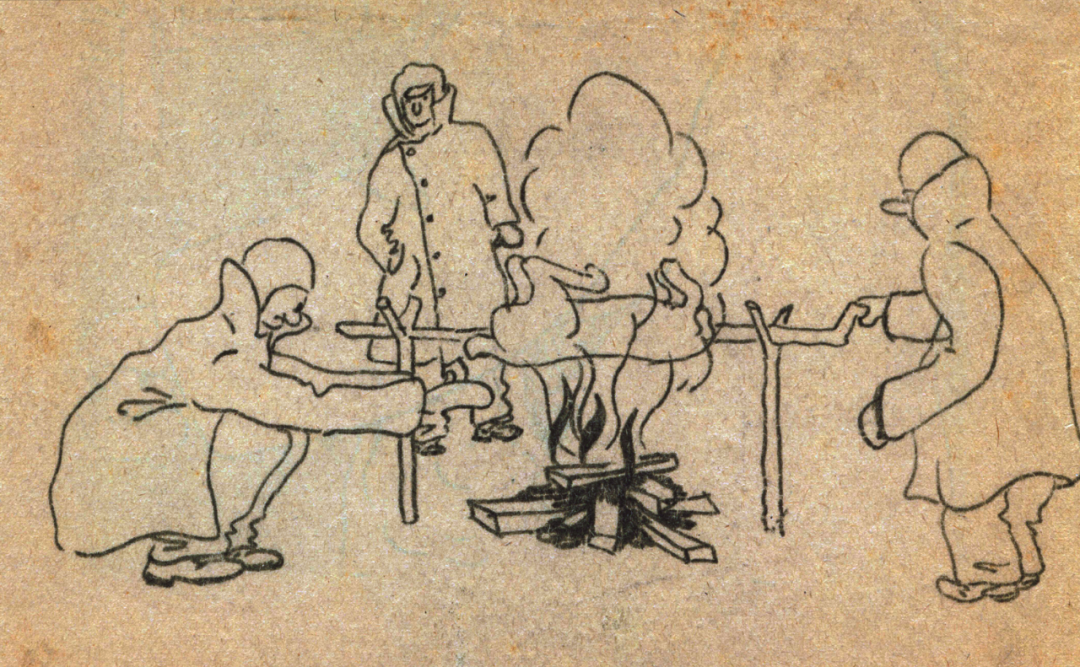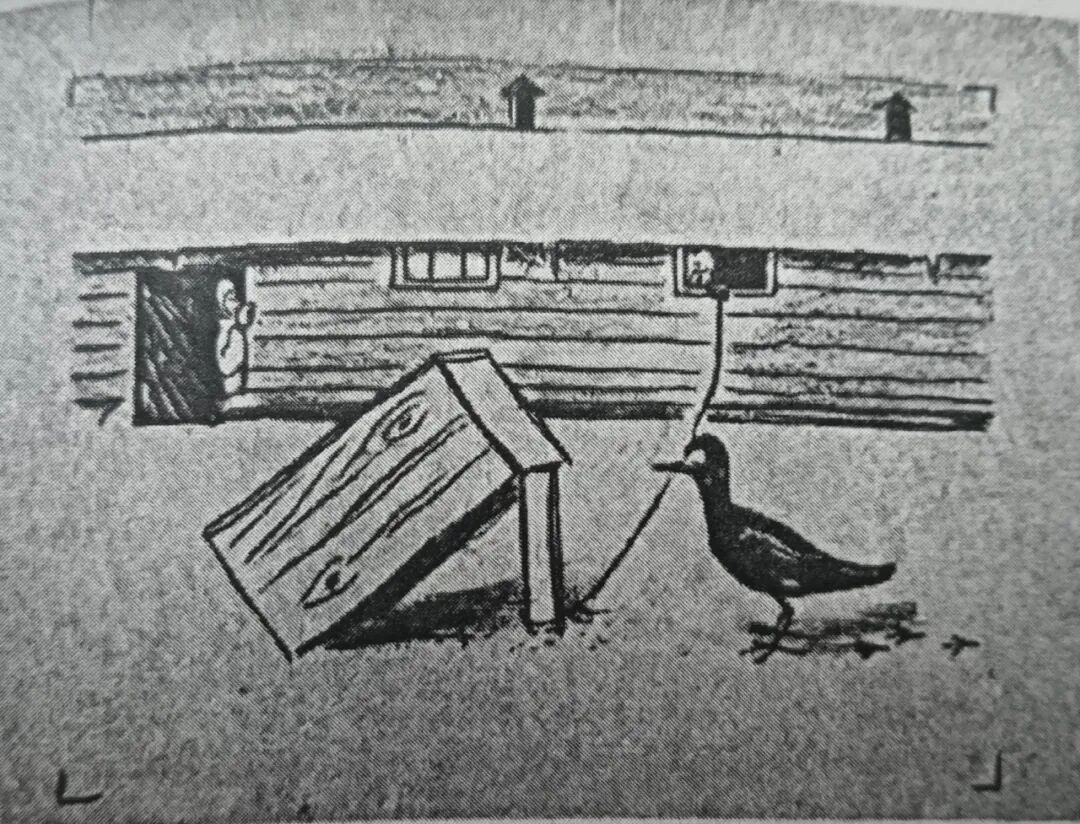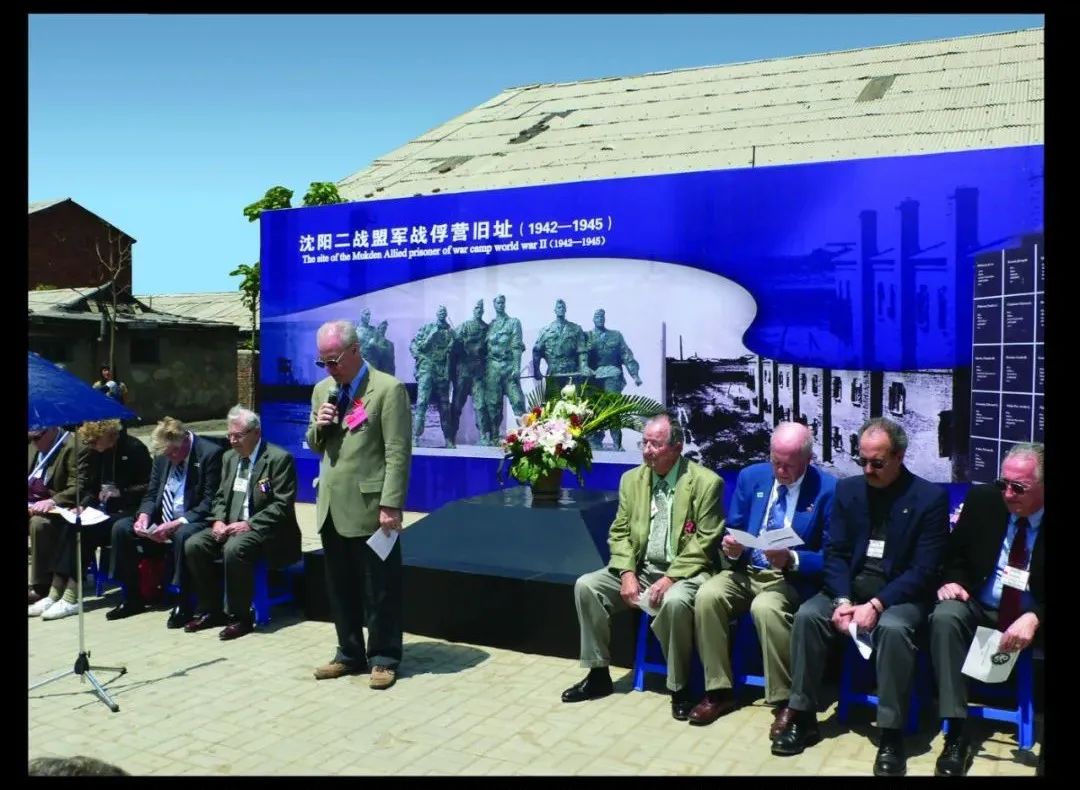全身赤裸接受量体的人;
Naked men with their measurements being taken;

一群日本医生在为战俘作检查。战俘认为他们来自731部队 (战俘威廉·沃特克画)
急于烤火取暖而全然没有注意到大衣已经被点燃的人;
Men "trying to get warm to get too close to the fires";

两位战俘急于烤火取暖而全然没有注意到大衣和鞋子已经被点燃 (战俘威廉·沃特克画)
在睡梦中从上铺跌落的人;
A man falling from the upper bunk while asleep;

在睡梦中从上铺跌落的人 (战俘威廉·沃特克画)
围着一圈烤着一只“土狗”的人;
Men "about to enjoy a feast of native dog";

肉总是很少,但有时会通过意想不到的方法得到。从战俘营铁丝网溜进来的狗成了战俘们的战利品 (战俘威廉·沃特克画)
躺在床上发出警报“一个伞兵团的床虱正从天而降”的人......
A man "warning the rest of the boys that the bed bugs were arriving by parachute…"

战俘诺亚·穆林斯告诉别人床上的臭虫是乘降落伞来的 (战俘威廉·沃特克画)
这些人有一个共同的称呼——二战盟军战俘。
从1942年底到1945年8月日本宣布投降,他们被囚禁在位于今天沈阳大东区的日军奉天战俘营中(奉天是沈阳的旧称)。而这些生动的描绘,则来自他们其中一位名为威廉·克里斯蒂·沃特克(William C. Wuttke)的美军战俘。我们知道画作的具体内容,是因为艺术家为每一幅都配上了简单而不乏幽默的文字。
These men shared a common identity — Allied prisoners of war during World War II. From late 1942 until Japan's surrender in August 1945, they were imprisoned in the Mukden POW Camp, run by the Japanese Imperial Army in what is now the Dadong district of Shenyang city in northeastern China, Mukden being the city's former name. The vivid scenes were the covert efforts of one man: an American POW named William C. Wuttke.

二战期间的奉天战俘营全貌

威廉·克里斯蒂·沃特克
奉天战俘营正式启用其实是在1943年7月——在此之前,战俘们被暂时关押在由九一八事变时被日军炸毁的东北军北大营营房改建的收容所里。新建的奉天战俘营占地近5万平方米,囚禁了超过2000名盟军战俘,是日本在亚洲设立的余115个战俘营中规模最大的。
此外,日军还在今天吉林省的双辽市和辽源市两地分别建立了奉天战俘营的第一、第二分所,主要用以被俘的盟军军官。二战期间菲律宾盟军总司令乔纳森·温莱特将军(Jonathan Wainwright)从1944年10月到1945年8月期间就被关押在吉林的分所。
The Mukden Camp, as it came to be known, did not officially open until July 1943. Before that, prisoners were temporarily housed in disused army barracks. Spanning nearly 50,000 square meters and holding over 2,000 Allied prisoners, the Mukden Camp was the largest of Japan's 115 POW camps across Asia during World War II. It also had two sub-camps located in Jilin province further north, where General Jonathan Wainwright, Commander of Allied forces in the Philippines during WWII, and other high-ranking Allied officers were confined.

今天得以部分保存的奉天盟军战俘营战俘营房及盥洗间
“坚硬如战舰的装甲”——这是温莱特对东北冻土的形容。由于土壤坚硬得难以开挖,死去的战俘——仅在1942年末至1943年初短短几个月内,就有近200名战俘因严寒与饥饿而丧生——的埋葬工作不得不拖到春天冰雪消融之时才能进行。这项工作本身也是由关押在营中的盟军战俘承担的。而在此之前,尸体只能堆放在仓库中,就连裹尸毯也常被其他战俘取走,用以御寒求生。
致力于奉天战俘营研究的历史学者杨竞在其著作《盟军战俘在中国》(Allied Prisoners of War in China)中记录了从战俘营中走出的罗伯特·罗森达尔(Robert Rosendahl)的一段回忆:当尸体开始解冻时,恶臭四溢,引来野狗觅食——饥饿至极的战俘们毫不犹豫地捕杀并吃掉了这些野狗。
"As solid as a battleship's armor" — that was how General Wainwright described the frozen earth of Northeast China. It was so impenetrable that the digging of burial pits for deceased POWs — nearly 200 POWs lost their lives to the brutal conditions in the few months between late 1942 and early 1943 — had to be delayed until late spring. In the meantime, bodies were stacked in a wooden storage shed, their blankets stripped away by fellow prisoners struggling to survive the relentless cold.
In Allied Prisoners of War in China (2018), Chinese historian Yang Jing records former POW Robert Rosendahl's account of the gruesome aftermath of winter: As corpses thawed, they began to emit a stench that attracted wild dogs — animals the starving prisoners killed and ate without hesitation.

埋葬死亡战俘的战俘营墓地

杨竞著作《盟军战俘在中国》
值得一提的是,在那个严冬中死去的许多战俘,从某种意义上说,早已是历经劫难的“幸存者”。他们先是从菲律宾遭受的日军最初空袭中幸存下来,菲律宾空袭是在日本偷袭珍珠港数小时后发动的,之后又挺过了臭名昭著的“巴丹死亡行军”。
在行军途中,投降的美菲士兵被迫在丛林中徒步行走百余公里,烈日酷暑、饥渴与虐待使他们纷纷倒下。最后,他们中的一部分人被送上一艘名为“鸟取丸”(Tottori Maru)的日军“地狱船”。
二战期间,日本军队将大量盟军战俘押运至各地劳工营,使用的运输船被称为“地狱船”。这些船只拥挤不堪,通风恶劣,食物和水极度匮乏,疾病和死亡率极高。战俘们在船上饱受饥饿、病痛和精神折磨,许多人未能挺过这段可怕的航程。

名为“鸟取丸”的日军“地狱船”
“鸟取丸”从马尼拉港出发,经过一个多月的航行,最终于1942年11月8日抵达朝鲜釜山港。三天后战俘们被押上火车,送往目的地——日本殖民统治下中国东北的奉天(今沈阳)。
Many of those who perished that bitter winter had already survived a gauntlet of horrors: the initial bombing of the Philippines — launched mere hours after Japan's surprise attack on Pearl Harbor; the notorious Bataan Death March, where surrendering American and Filipino soldiers were forced to trudge over 100 kilometers through jungle heat and brutality, collapsing one by one along the way; and the harrowing journey aboard a Japanese "Hell Ship" — in this case, the Tottori Maru — so squalid and inhumane it earned the grim title of a "floating tomb" before delivering its emaciated captives to Busan, Korea, from where they boarded a train to Shenyang, as the British and Australian POWs of the camp mainly came from Singapore and Hong Kong.
如今,营地昔日的围墙、铁丝网与岗哨早已不复存在,但水塔和曾与锅炉房相连的烟囱仍然高耸在那里。几步之遥就是2013年建成开放的二战盟军战俘营旧址陈列馆。馆中展陈的每一件文物,都承载着战俘们曾经的挣扎与对战争终结的无限渴望。
Today, the camp's outer walls — once topped with barbed wire and watched over by guard towers — are long gone. Yet, a water tower and a tall chimney, once linked to the camp's boiler room, still stands. In their shadow, a new building has been erected to display a miscellany of artifacts — mementos from days the POWs had desperately hoped would soon come to an end.

奉天盟军战俘营旧址烟囱与水塔
严寒、饥饿、虐待和疾病无时无刻不在折磨着战俘们。253号战俘埃德蒙·杰米森(Edmund Jemison)因严重营养不良几乎失明,战后进行了长期治疗才得以部分康复。然而战俘们却不愿向亲人们吐露他们的真实处境:在一封写给父亲的信中,威廉·布罗拉(William Burrola)说自己和哥哥约瑟夫——两人都是被囚于奉天战俘营的美军士兵——“受到了良好照顾”。“又见到雪真好,”布罗拉写道,“又是一个圣诞节了。”
It's particularly heart-wrenching for a museum visitor to read the letter written by William Burrola to his father, telling the old man that he and his older brother Joseph — both imprisoned at Mukden — "are being well taken care of". "It was sure good to see snow gain," wrote Burrola, noting that "it is another Christmas".

战俘威廉·布罗拉(William Burrola)写给父亲的信件
然而这样的生活终究是难以忍受的。1943年6月23日,三名美军战俘从奉天营出逃,他们几天后被日军抓捕并于7月31日被处决,其中最年轻的费迪南德·梅林戈洛(Ferdinand Meringolo)年仅20岁。
协助他们逃跑的是年仅19岁的中国工人高德纯——高与他们同在日本在沈阳设立的工厂“满洲工作机械株式会社” (简称MKK)里面劳役。这类工厂主要进行军工和重工业生产,是日军维持其在亚洲战场军事行动的重要后勤支撑设施。
高为三位逃跑的战俘提供了一张东北地图,也因此遭受毒打并被判刑十年,直到1945年8月15日日本宣布投降,才得以提前获释。
Some attempted to escape. On June 23, 1943, three American POWs escaped from Mukden Camp but were recaptured and executed on July 31. The youngest, Ferdinand Meringolo, was just 20 years old. Their escape was aided by Gao Dechun, a 19-year-old Chinese laborer at the factory where they worked, who risked his life to obtain a map of Northeast China. Japan operated many factories in northeastern China to support its military-industrial efforts, where the POWs were condemned to forced labor. For his bravery, Gao was severely beaten and sentenced to 10 years in prison — a term terminated by Japan's surrender on Aug 15, 1945.

美国媒体上关于三名逃跑战俘被日军处决的报道,照片中为费迪南德·梅林戈洛
沃特克就是一位在同一家工厂绘图车间工作的美军战俘,他在被关押期间秘密地用近百幅漫画记录了战俘营的真实生活。“沃特克因为是制图员,手上能接触到绘画工具和材料。但真正让这些漫画诞生的,是他们用创造力去抗争残酷的囚禁生活的决心。”陈列馆的副主任李卓然说。
Wuttke, author of nearly 100 cartoons capturing the brutal realities he and his fellow POWs endured at Mukden Camp, worked in the drafting office of that same factory. "Wuttke had access to drawing tools and materials as draftsmen. But what truly made these caricatures possible was his resolve to defy camp life through creativity," says Li Zhuoran, deputy director of the site museum.

战俘进行劳役的工厂之一——“满洲工作机械株式会社”(1945年摄)
沃特克于1977年去世后,他的妻子莉莲·沃特克·德贾科莫(Lillian Wuttke deGiacomo)和儿子彼得共同执笔一部关于他本人的传记《再撑一天》 (Just One More Day)。书中写到,沃特克常把画好的作品“贴在身上”,从工厂偷带回营房,以躲过日军每天的搜身——而这一幕也被他画进了漫画。
In Just One More Day, cowritten by Wuttke's wife Lillian and son Peter after the man's death in 1977, Wuttke is described as smuggling drawings from the factory to his barracks "by plastering them to his body" to evade the guards' daily pat downs — a routine he duly captured in one of his caricatures.

沃特克画笔下日军每天的“搜身”
饥饿、寒冷与恶劣的环境,是沃特克画作中反复出现的主题。一幅画里,战俘们为了“增加蛋白质摄入”设陷阱抓鸟;另一幅画中,一个战俘“若无其事地从菜园顺走一根胡萝卜状的蔬菜”——沃特克在画注中写道:“要是被抓,挨顿狠揍还算轻的。”他几乎从不放过为画作配上辛辣讽刺文字的机会。
Hunger, cold, and squalid conditions are recurring themes in Wuttke's drawings. One sketch shows POWs "trying to improve their protein intake" by setting a trap for a bird; another depicts a prisoner "acting nonchalant while filching a carrot-like vegetable from the garden".
"If caught, a severe beating would be the least of his worries," Wuttke noted, rarely missing the chance to pair each illustration with a biting caption.

沃特克画笔下战俘们设陷阱抓鸟
幽默在这里,不只是艺术手法,更是苦难中的解压阀——用笑声对抗精神与肉体的折磨,正如那个警告大家“一个伞兵团的床虱正从天而降”的战俘所做的那样。现实中,虱子、跳蚤与臭虫在营房里泛滥成灾,常让人彻夜难眠,只能用手一只只捏死——它们常藏在衣缝里。
Here, humor was more than an artistic device — it was a means of finding levity in suffering, of preserving sanity by pushing back against the physical and psychological toll of captivity. In one sketch, a POW "warns the rest of the boys that the bedbugs were arriving by parachutes". In reality, lice, fleas, and bedbugs were so rampant in the barracks that they caused countless sleepless nights and had to be pinched to death.
疾病毫无悬念地蔓延开来——痢疾、疟疾、肺炎、伤寒和脚气病在战俘营中肆虐。患脚气的人不堪其苦,甚至会把靴子里塞满雪,或用冰水浸脚缓解疼痛。
The harsh conditions fueled the spread of disease both infectious and environmental, with the most rampant being dysentery, malaria, pneumonia, typhoid, and beriberi. For the latter, some sufferers even packed their boots with snow or soaked their feet in icy water to ease the pain.

2007年5月,美国老兵及其家属在盟军战俘营旧址举行追思活动
日军派来了医生,但他们动机令人怀疑。
奉天战俘营隶属于日本关东军,而关东军不仅统治着被日军侵占的中国东北,还直接管理总部设在哈尔滨的秘密生物武器研究和人体试验基地——731部队。在沃特克的画作中,全裸的战俘被日军医生测量身体数据——画注中提到,这些医生“被认为是来自731部队”。
Japanese doctors were brought in, but their motives were highly suspicious — especially given that Mukden Camp was under the control of the Kwantung Army, which not only ruled much of occupied northeastern China but also oversaw Unit 731, the infamous biological warfare unit of the Imperial Japanese Army.
Included in Wuttke's portfolio is a drawing of POWs — all naked — undergoing various measurements by Japanese doctors "believed to be from Unit 731" as noted by the author.
据太平洋战争史学家、美国政府跨部门二战罪行解密工作组顾问琳达·戈茨·霍尔姆斯(Linda Goetz Holmes,1933—2020)在其著作《天皇的客人:日本奉天战俘营的秘密历史》(Guests of the Emperor: The Secret History of Japan's Mukden POW Camp)中披露,1943年初,731部队的日本医疗人员确实到过奉天营,对包括美国人在内的盟军战俘进行人体实验。
In her book Guests of the Emperor: The Secret History of Japan's Mukden POW Camp, Linda Goetz Holmes (1933-2020), the first Pacific War historian appointed to advise the US government Interagency Working Group declassifying documents on World War II crimes, asserts that Japanese medical personnel from Unit 731 visited Mukden Camp in early 1943 and conducted human experimentation on Allied prisoners, including Americans.

位于黑龙江省哈尔滨市平房区的侵华日军第七三一部分罪证陈列馆
沃特克曾在其一幅漫画下面写到,一旦战俘失去吃饭的意志,“就差不多走到尽头了”。守住希望就是守住生命:一位战俘用废弃的木板制作了一把低音提琴,而这一幕也被沃特克画了下来。令人动容的是这把承载着对生的渴望的提琴后来出现在1945年8月20日苏军解放战俘营后的一张合影中:渡尽劫波的战俘们面对镜头唱起了一首怀乡的歌曲,在他们中间占据C位的是那把低音提琴。
还有一张黑白照片同样耐人寻味:昔日的日本看守,在重获自由的战俘监督下收土豆——这种角色反转的深刻讽刺,想必是沃特克最乐于品味的。
Wuttke once observed that once a POW lost the will to eat, "it was almost over". Recognizing the importance of staying hopeful, one prisoner managed to gather enough scraps of wood and old boxes to build a full-size bass fiddle — an act captured in one of Wuttke's caricatures. Remarkably, the bass reappears in a group photo taken after the camp's liberation by Soviet troops on Aug 20, 1945, standing as a powerful symbol of the unconquered human spirit.
Equally striking is a black-and-white photograph showing former Japanese guards harvesting potatoes — this time under the watchful eyes of newly liberated Allied POWs. "The role reversal is the ultimate satire, the kind that the camp artists would have truly savored," says Li.

有一个战俘用木头碎片和盒子做了一个大提琴(战俘威廉·沃特克画)

获救战俘唱起了美国歌曲“怀乡之旅”,表达盼望回家的心情

原来的日本看守在获救战俘的看管下收土豆
1945年9月2日,麦克阿瑟将军在东京湾的“密苏里号”战舰上签署了日本的投降书,并在现场将签字用的钢笔赠给了温莱特将军......1945年9月9日,日本中国派遣军总司令冈村宁次在南京大礼堂正式向中国战区授降。
On Sept 2, 1945, aboard the USS Missouri in Tokyo Bay, General MacArthur signed Japan's Instrument of Surrender, before passing the pen to General Wainwright, honoring him with a deeply symbolic gesture.
前奉天战俘营美军战俘拉尔夫·格里菲斯(Ralph Griffith)在一次采访中回忆起他“获得自由的第一天”:一个中国小女孩在营门外牵起他的手,带他走进一家普通人家。他在那里喝到了米酒,吃上了热饭。
“我17岁参军时,可以选择去夏威夷、阿拉斯加、巴拿马或菲律宾。我问征兵官哪儿最远,然后就选了那里。”他回忆说。
Ralph Griffith, a former POW of the Mukden Camp recalled his "first free day", when a little Chinese girl at the camp gate took his hand and motioned for him to follow. She led him to a nearby home, where he was welcomed with rice wine and a hot meal.
"When I signed up for the army at 17, I had my choice between Hawaii, Alaska, Panama and the Philippine Islands. I asked the recruiting officer which was the farthest away and told him that's what I wanted," he recalled.

前奉天战俘营美军战俘拉尔夫·格里菲斯(Ralph Griffith)
2007年5月,格里菲斯重返沈阳——这是他自1945年获释以来第一次踏上这片土地。他于2020年去世,享年96岁。如今,在仅存的两层砖房营舍中,一尊老年格里菲斯的蜡像静坐于床铺之上。蜡像满头银发,神色凝重——陈列馆以这样一种独特的形式,向一位曾经向死而生的老兵致敬。
In May 2007, Griffith — who passed away in 2020 at the age of 96 — returned to Shenyang for the first time since his release in 1945. Today, a wax figure of him as an elderly man sits alone on the lower bunk of a bed inside the sole surviving two-story brick barrack once used by POWs — a quiet tribute to his visit.

2007年重返奉天战俘营的格里菲斯在曾经被囚禁的营房内驻足

格里菲斯的蜡像与复原的战俘营房
今天,陈列馆是其所在的沈阳市大东区国防教育基地,每年都有很多小学生中学生来这里参观,或是做志愿讲解员。

小志愿者在给参观陈列馆的观众做讲解
在《再撑一天》这本书中,沃特克的妻子莉莲在谈到丈夫之所以能够活着走出战俘营时写到:“他一直相信,只要再撑一天,就能活下去。”
In Just One More Day, Lillian Wuttke DeGiacomo wrote about her husband's survival while imprisoned at the camp, "He always believed he could make it just one more day."

沈阳二战盟军战俘营遗址陈列馆
记者:赵旭
实习生:徐苗苗
|
|
 /1
/1 